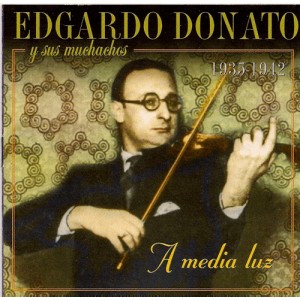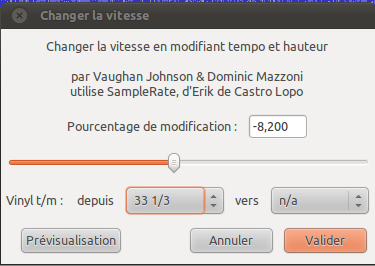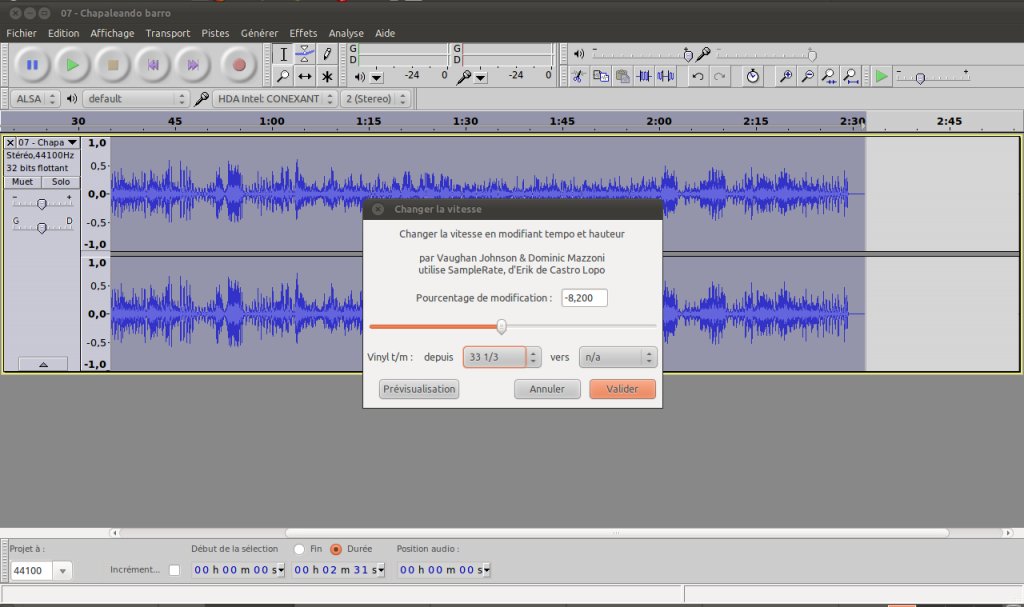I was recently looking at the Edgardo Donato recordings in my collection when I noticed that some of the same tangos produced at the same recording date differ in duration. Certain El Bandoneón recordings are of a shorter duration than the corresponding recordings from other labels. I recalled that I have read before articles on tango blogs which mention this problem: Several El Bandoneón recordings are too fast in speed and therefore show a too high pitch (The problem seems to be even wider spread and is not limited exclusively to the El Bandoneón label).
In the case of my Edgardo Donato recordings I checked on the title Chapaleando barro from the recording year 1939 (31st of August 1939 according to tango.info) and recognised that all other CD labels present the same duration of the music part in the recording which is 2:28 min (2:31 with beginning and ending silence). The El Bandoneón recording is shorter: 2:17 min (2:19 min with silence) which makes a clearly perceivable difference of 0:11 sec. Chapaleando barro from El Bandoneón is much faster and the voices and instruments are distorted and sound too high! Here are the sound samples without any processing:
- This is the original El Bandoneón version of Donato’s Chapaleando barro taken from the CD A Media Luz 1935 – 1942 EBCD95 before my processing, it’s too fast and too high in pitch:
- And this is a sound sample of my reference version of Donato’s Chapaleando barro taken from the japanese CD Qué Lindos Tiempos Viejos Vol. 22 AMPCD1265, both tempo and pitch sound perfect to me:
Therefore I decided to pass the El Bandoneón Chapaleando barro through a time stretching filter in Audacity, a very versatile open source sound editing software. The literature on time stretching algorithms allows to believe that the current state of art is quite good, especially when stretching at low percentages like in this situation.
As all CD labels must have used either the same master 78 R.P.M. or a circulating record copy of the original recording from 1939, I tried first to figure out what could have happened during the transfer to CD in the El Bandoneón studio and came up with three theories:
- A turntable in their studio was running too fast maybe at round 80 R.P.M., certain labels like Pathé produced records which used to be played back at 80 R.P.M.
- A turntable was out of order and therefore running at a slightly higher speed which also confirms that the speed difference is not always exactly the same as I later noticed on other distorted El Bandoneón tangos.
- They used a variable speed turntable and manually affected arbitrary speeds between 78 – 85 R.P.M according to what sounded good in their ears, maybe even intentionally increasing speed to please their customers and a taste for faster music.
- But most likely they were just doing their transfers from vinyls which already had this pitch deviation.
I would be curious to know what happened exactly in that studio but I think the 4th theory is the most plausible.
For the tango recording Chapaleando barro I calculated a deviation of 8,2 % which would suggest that the playback speed during the transfer of the record must have been at around 84.396 R.P.M. (Please see this blog contribution on other methods for determining the acceleration factor, when you don’t have any reference tango at the correct speed at hand for a precise calculation).
To correct this kind of recording error the corresponding Audacity filter is called Change Speed, affecting both Tempo and Pitch under the Effects menu. I wanted to inverse the error and therefore reduce the speed while correcting the pitch (changing to lower notes) and the tempo (lower BPM). Let’s see practically how to process:
Open the sound file with Audacity’s open dialog. Select the whole sound file via the Edit menu, select all. Call the Change Speed, affecting both Tempo and Pitch filter dialog via the Effects menu.
In the filter window the correction percentage has to be introduced with a negative prefix: -8.2 % as we want to have the filter slowing down the speed of the sound file.
Prior to applying the filter check that the whole sound file is selected:
Best is to save the resulting file with a different name and the same meta-data, so you can later compare the duration if you have some reference versions of the same tango in your collection. To save the file use the Export menu which you can access via the File menu. Once the export is done, drop all changes to the open file. This permits to keep the original speedy sound file.
See here the original sound sample, before:
And here the processed slowed down version, after:
- Sound sample of the restored El Bandoneón version of Donato’s Chapaleando barro, after being passed through the Audacity filter:
I draw several frustrating conclusions form this experience. The first is that I recognise that I can’t trust some El Bandoneón recordings for accurate speed and I also see that DJs who are working directly with CDs, the old way, are potentially unable to correct these errors as you can’t just pitch these tracks down without getting some inversed Mickey Mouse effect. And the second is that it would take ages to correct all the speed problems with this kind of tangos, the filter passage can be time consuming depending on your CPU. What a waste! But after all it’s not so dramatic 😉 there is also the possibility to just tag these tangos as fast versions. Some DJs told me that they play the fast versions when the mood of the evening is demanding for faster music.
Not everything coming from El Bandoneón is bad. In fact when I browse through my listings, I can see only a small amount of speedy versions. I like a lot of their CD editions because they have also compiled nearly for each CD a nice leaflet with extra information and the quality of their transfers is often quite amazing. I just recently brought back a big bunch of recordings from Barcelona. There is a very good shop close to the metro station Maria Christina called Blue Sounds where they have a huge selection of El Bandoneón CDs for takeaway. The shop is affiliated with the tango label but mostly specialised in Jazz records, most of which are coming from their own label. The shopkeeper told me that El Bandoneón stopped producing 3 years ago and soon when the stocks are sold out, these recordings will not be available anymore.




Well said! I noticed also (in my old tango collection which no longer exist :() that some of my versions have different times. And what an analysis! 🙂 DJ Jens-Ingo, to more music and tango next year! Abrazos
The article sounds very convincing. I did not check all recordings, but it confirms what i thought to hear for longer time. And Perhaps it is not so strange to expect speed differences, as you see this effect also in many old films. (recorded around the same time)
Regarding “Donato’s Chapaleando barro”
I have a Donato_Horacio Lagos 1938 – 2:17 version but with a surprise, it is not a tango but a vals at a good tempo… in my opinion.
Jens, a lot of El Bandoneón’s output is LP transfers. Is it possible do you think that the LP (from the 1960s or 1970s) was mastered at the wrong speed?
Hello Michael,
i also recognised that El Bandoneón has used extensively LPs transfers for their CD editions. If you look at the “El Rey Del Compás EBCD43” and listen to the track “El cencerro” as an example, they used definitively a LP because it’s a strongly echoed version. The reverb filter has been used on certain RCA Víctor LP collections, like some tracks on the 10 LP Set “Serie Tango De Ayer” from 1980 which has been cut by different subcontractors like by Sonolux in Columbia on quite cheap and light vinyl (180 gramms max.), especially on LP n#3 “Juan D’Arienzo con Rudolfo Biagi al piano 1936-1938 Vol. 3”. I guess it must have been a kind of bestseller edition when serveral subcontractors had to fabric it. The original 78 RPM record from 1937 has no reverb filter, they were not invented yet! There were nearly no secondary labels issuing d’Arienzo at that time because of high production costs and tighter licence policies. El Bandoneón might have used this RCA series or a simular, or at least another CD edition which used the RCA Víctor reverb version of “El cencerro”. RCA Víctor also issued top of the top transfers with their CAMDEN series on plain heavy vinyl. It has been presented as an audiophile edition recut from their masters. There is still a possibility that the speed issues could be from tape machines which were used to copy the LPs. I have recognised for example a lot of too fast recordings on the Oscar Himschoot CdT CDs, most of the late D’Arienzo are too fast and missing dynamics. The original LPs from RCA Víctor are perfect though. So I guess there must have been something intermediate between these two medias.
The famous reverberation effect comes defintively from LP editions. I haven’t had time to check the timings but from my listening memory i can’t recall anything obvious from the RCA CAMDEN transfers, the Odeón LPs are also all close to perfect. I remember though some possible timing issues on this above metioned 10 LP Set, also very poor recording quality on its Donato (Vol.6). I will try to make a more in depth analysis of the problem in the next future. This article is now nearly 2 years old and I think today too that it is most likely that the El Bandoneón timing issues are from LPs or Tapes which introduced the errors.
Thank you very much for this important input and I keep you posted once I have checked this more in depth.
Jens wrote: “ I have recognised for example a lot of too fast recordings on the Oscar Himschoot CdT CDs … The original LPs from RCA Víctor are perfect though.”
Why do you conclude that it is the recordings of Himschoot that are incorrect, and those of RCA are correct – rather than the other way around?
Hello Chris,
this conclusion is based on an analysis of the tonal keys and the sound quality of both material. Most of the CdT CDs are off tune and the sound quality is quite poor which means that in terms of copy generations these transfers seem to be copies of transfers and not remasterings of 78 rpm records or masters. This is also true for El Bandoneón CDs. With most El Bandoneón material one can also observe that they copied forth a lot of artefacts which have been introduced on LP reeditions and which do not exist on the 78 rpms, like strong reverberation effects or the before mentioned pitch issues. Listen to their version of “El cencerro” by D’Arienzo on EBCD43 “El Rey Del Compás”.
Greetings,
JI
Pingback: El cencerro | Jens-Ingo's Tango DJ
Hi Jens
Eine weitere CD, wo die Musik in höherer Geschwindigkeit transferiert wurde, ist die Carlos di Sarli “Primeras Grabaciones 1928-31 (BMT 020). Gut zu hören bei dem Stück Cicatrices. Als Vergleich das gleich Stück auf der CD “Col. 78 rpm -Carlos di Sarli 1928-31”.
Another CD where the music has been transferred with higher speed is to find on Carlos di Sarli “Primeras Grabaciones 1928-31 (BMT 020). Easy to hear e.g. on Cicatrices.
Thanks for your good article.
Michele K.
Hi Jens, nice article indeed. Just a question I could not figure out the answer to from any of the referenced links. How do you get to 8.2% variation? What is(are) the formula(s)?